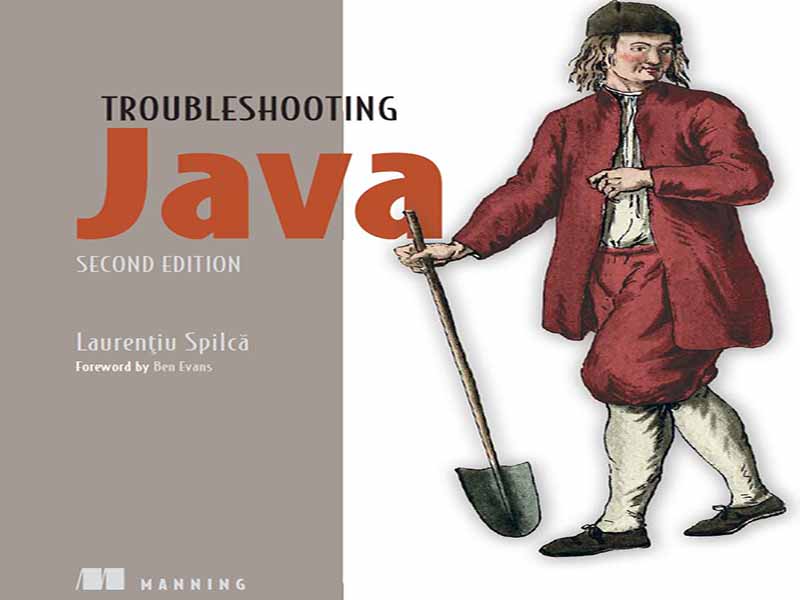- عنوان کتاب: Troubleshooting Java, Second Edition
- نویسنده: Lauren iu Spilc
- حوزه: برنامهنویسی جاوا
- سال انتشار: 2026
- تعداد صفحه: 362
- زبان اصلی: انگلیسی
- نوع فایل: pdf
- حجم فایل: 7.76 مگابایت
ممکن است از قبل با لورنسیو اسپیلکا از طریق کتابهایش «امنیت بهار در عمل» و «شروع بهار از اینجا» آشنا باشید، اما اگر نه، کتاب «عیبیابی جاوا» مقدمهای عالی بر سبک منحصر به فرد نگارش و طنز فراگیر او ارائه میدهد. اگر در توسعه جاوا تازهکار هستید، ممکن است پوشش دقیق او از مفاهیم را بسیار مفید بیابید، به خصوص هنگامی که با پوشش کامل ابزارهای موجود (رایگان) و نحوه استفاده از آنها ترکیب شود. علاوه بر این، این کتاب شامل مثالها و نمایشهای زیادی از آنچه میتواند اشتباه پیش برود، برای کمک به شما در ایجاد تجربه و اعتماد به نفس در استفاده از ابزارها است. بخش 1 بر اشکالزداها تمرکز دارد و ابزارهای رایج مانند اشکالزدای IntelliJ CE – هم قابلیتها و هم محدودیتهای آنها – را پوشش میدهد. برخلاف بسیاری از منابع دیگر، لورنسیو چندین تکنیک اشکالزدا را پوشش میدهد که فراتر از اصول اولیه هستند، مانند نقاط شکست شرطی و نقاط شکست بدون مکث. همچنین پوشش کاملی از اصول اولیه عیبیابی برنامههای جاوا با استفاده از گزارشها وجود دارد. در بخش 2، موضوع کلیدی مصرف منابع و نقش اصلی آن در عیبیابی، در اولویت قرار دارد. ابزار رایگان VisualVM به عنوان وسیله اصلی برای درک این حوزه و مفاهیم مرتبط با آن عمل میکند. پوشش عمیقی از مباحث مهمی مانند نمونهبرداری و ابزار دقیق CPU و نحوه استفاده مؤثر از ابزارها وجود دارد. یک حوزه ضروری، اما اغلب نادیده گرفته شده، – مدیریت وابستگیهای خارجی – به طور مرتب از طریق مثالی از یک پایگاه داده SQL با استفاده از Hibernate به نمایش گذاشته شده است. موضوع برنامهنویسی چندرشتهای، و به ویژه عیبیابی قفلها، به طور طبیعی از پروفایلینگ CPU پیروی میکند. بخش 3 به مسائل مربوط به حافظه، از جمله ردیابی نشت حافظه با تکنیکهای نمونهبرداری و پروفایلینگ، و همچنین ایجاد و پیمایش heap dumps اختصاص داده شده است. تکنیکهای عملی، مانند فیلتر کردن انواع JDK و استفاده از قابلیتهای VisualVM برای در نظر گرفتن اشیاء زنده، و همچنین استفاده از OQL برای پرس و جو از heap dumps نیز پوشش داده شده است. درست مانند بخش ۱، استفاده از لاگها (در این مورد، لاگهای GC) موضوع فصل آخر بخش ۳ را تشکیل میدهد. در پایان، لورنتیو ما را به گشت و گذاری سریع در سیستمهای بزرگتر میبرد، که با مقدمهای بر ردیابی توزیعشده به عنوان یک تکنیک کلیدی شروع میشود، و سپس با بحث در مورد تراکنشهای توزیعشده در سیستمهای ناهمگن، همه چیز را به هم پیوند میدهد. در سراسر کتاب، لورنتیو با تأکید بر فقدان گلولههای جادویی و تمرکز بر موارد استفاده عملی، از ابزارهای هوش مصنوعی با دقت و تاکتیک استفاده میکند. اگرچه این ابزارها نمیتوانند جایگزین کاربر انسانی شوند، اما میتوانند یک مهندس ماهر را پربارتر و قادر به تمرکز بر دغدغههای سطح بالاتر کنند. نتیجه نهایی کتابی است که برای تازهکارها مناسب است، اما آیندهنگر نیز هست و تشخیص میدهد که چگونه ابزارهای مدرن میتوانند شهود، تجربه و بینش حل مسئله مهندسان نرمافزار شاغل را تکمیل و تقویت کنند.
You may already be familiar with Laurențiu Spilcă from his books Spring Security in Action and Spring Start Here, but if not, Troubleshooting Java provides a great introduction to his unique style of writing and pervasive humor. If you’re a newcomer to Java development, you may well find his careful coverage of concepts extremely useful, especially when combined with thorough coverage of the available (free) tools and how to use them. In addition, the book includes many examples and demonstrations of what can go wrong, to help you build experience and confidence in using the tools. Part 1 focuses on debuggers and covers common tools like the IntelliJ CE debugger— both their capabilities and their limitations. Unlike many other resources, Laurențiu covers several debugger techniques that go well beyond the basics, such as conditional breakpoints and nonpausing breakpoints. There’s also solid coverage of the basics of troubleshooting Java applications using logs. In part 2, the key topic of resource consumption and its central role in troubleshooting is front and center. The free VisualVM tool serves as a primary means of understanding this area and its related concepts. There is in-depth coverage of important topics such as CPU sampling and instrumentation and how to use the tools effectively. One essential, but often overlooked, area—the handling of external dependencies—is neatly showcased via the example of an SQL database using Hibernate. The subject of multithreaded programming, and especially troubleshooting locks, follows naturally from CPU profiling. Part 3 is devoted to memory-related issues, including tracking down memory leaks with sampling and profiling techniques, as well as creating and navigating heap dumps. Practical techniques, such as filtering out JDK types and using the capabilities of VisualVM to consider live objects, are also covered, as well as the use of OQL to query heap dumps. Just as in part 1, the use of logs (in this case, GC logs) forms the subject of the last chapter in part 3. To conclude, Laurențiu takes us on a quick tour through larger-scale systems, starting with an introduction to distributed tracing as a key technique, before tying it all together by discussing distributed transactions across heterogeneous systems. Throughout the book, Laurențiu makes careful and tactical use of AI tools, stressing the lack of magic bullets and focusing on practical use cases. While these tools cannot replace a human user, they can make a proficient engineer more productive and able to concentrate on the higher-level concerns. The end result is a book that is suitable for newcomers but is also forward-looking and recognizes how modern tooling can complement and enhance the intuition, experience, and problem-solving insight of working software engineers.
این کتاب را میتوانید از لینک زیر بصورت رایگان دانلود کنید:
Download: Troubleshooting Java, Second Edition




































نظرات کاربران